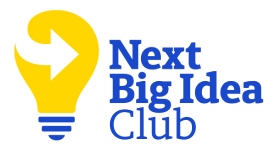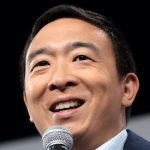READ ON TO DISCOVER:
- The real reason Donald Trump got elected
- The surprising position shared by Thomas Paine and Martin Luther King
- How we can afford to pay citizens $12,000 per year, with no strings attached
Andrew Yang is a 2020 Democratic presidential candidate. He is the founder of Venture for America, a major non-profit that trains the next generation of entrepreneurs, and the bestselling author of The War on Normal People: The Truth About America’s Disappearing Jobs and Why Universal Basic Income Is Our Future. He recently sat down with Next Big Idea Club founder Rufus Griscom to discuss the big idea at the center of his platform: giving away $1,000 per month to every American adult, a move that, according to Andrew, could save our country’s economy.*
This conversation has been edited and condensed. Listen to the full version on the Next Big Idea podcast.
Rufus: Your book, The War on Normal People, contains an extraordinary mixture of dire pessimism and beautiful visions of what’s possible. How bad is our current situation?
Andrew: I spent seven years running a nonprofit called Venture for America, and I was blown away by the gulf between different regions in this country. You feel like you’re crossing dimensions if you travel between St. Louis and San Francisco, or Michigan and Manhattan. And I wrote the book to try and figure out why my unease was so high, particularly after Donald Trump won.
If you turn on cable news, you would think that Donald Trump is our president today because of some mixture of Russia, Hillary Clinton’s emails, and Facebook. But I’m a numbers guy, and when I looked at the numbers, it was clear to me that during recent years we blasted away four million manufacturing jobs, and those jobs were primarily in Ohio, Pennsylvania, Wisconsin, Michigan, Missouri, and Iowa. If that list sounds familiar, those are the swing states that Donald Trump won. And what we did to those manufacturing jobs is what we are now doing to retail jobs, call center jobs, fast food jobs, eventually trucking jobs, and on and on through the economy.
We’re in the midst of the greatest economic transformation in our country’s history, the fourth industrial revolution. And Donald Trump is a symptom or a manifestation of the fact that we’re in the third inning of this transformation, and doing nothing about it.
If you doubt that this is already transforming America’s way of life, our labor force participation rate is down to a multi-decade low, about 63 percent, the same levels as El Salvador and Costa Rica. And our life expectancy has declined for the last three years in a row because suicides and drug overdoses have both overtaken vehicle deaths for the first time in American history. It is highly unusual for the life expectancy in a developed country to decline one year, let alone three years in a row—the last time it happened in the U.S. was a hundred years ago during the Spanish flu of 1918, a global pandemic that killed millions.
So we’re back in pandemic territory in terms of its impact on U.S. life expectancy. These problems drove Donald Trump into the White House, and they’re going to get worse as 30 percent of stores and malls close, and AI starts assuming the work of call center workers, truck drivers, and more.
Rufus: That’s pretty scary. So we should not be reassured that the unemployment rate is at a historic low of 3.5 percent? You would say that is unrepresentative of reality?
Andrew: We have three headline measurements to see how we’re doing in America today: GDP, stock market prices, and the headline unemployment rate. And each of these is somewhere between problematic and disastrous in practice. GDP is at record highs even as life expectancy is declining. And something like self-driving trucks will be tremendous for GDP—they’ll save 168 billion dollars a year in various expenses—but it’s going to be disastrous for the 3.5 million truckers and the 7 million Americans who work in truck stops, motels, and diners around the country.
As for stock market prices, the bottom 80 percent of Americans own 8 percent of stock market wealth, and the bottom 50 percent own essentially zero. So if you’re trumpeting stock market prices, you’re tracking the fortunes of the top 20 percent of the country.
When it comes to headline unemployment, if you drop out of the workforce and get discouraged, it actually improves the unemployment rate—the headline unemployment rate doesn’t take into account labor force participation. It also doesn’t take into account the fact that 94 percent of new jobs are temp, gig, or contract jobs that often don’t have healthcare benefits or a path forward. It doesn’t account for the fact that 40 to 44 percent of recent college grads are doing a job that doesn’t require a degree. None of those things show up in the headline unemployment rate—it’s almost intentionally obscuring a lot of the ugly reality. So we need to upgrade to measurements that actually tell us how we’re doing. You can’t solve a problem if you can’t see it.
Rufus: Let’s talk about what’s coming—I think you call it “the great displacement.” How many people do you think will be displaced in what amount of time?
Andrew: 33 percent of Americans graduate from college—42 percent if you include two-year degrees. So if you look up at the American workforce, you’re looking at mostly high school grads. What jobs do high school grads fill in our economy? Number one is office and administrative positions, including call centers. Retail and sales is number two—those are all the mall workers and the cashiers. Food service and food prep is number three. Truck driving and transportation is number four, and manufacturing is number five. But those are not the five biggest employment categories of high school grads in America—those are the five biggest employment categories period. About half of Americans work in one of those five job categories.
“We need to upgrade to measurements that actually tell us how we’re doing. You can’t solve a problem if you can’t see it.”
Let’s look at each of them: In administrative and office-related work, there are 2.5 million call center workers in the U.S. making fourteen dollars an hour. How long will it be before AI and software can do a lot of that job? Let’s call it two or three years, although I think it’s technically feasible right now, because you just need a good decision tree and a bunch of voice prompts.
Retail and sales: 30 percent of America’s stores and malls are closing right now because of Amazon. The average retail worker is a 39-year-old woman making between nine and ten dollars an hour—when her store or mall closes, what’s her next move?
And you know those self-serve kiosks you see at a McDonald’s or fast food restaurant? McDonald’s says they’ll be in every location in the U.S. in the next two years. And then they’re going to start looking at the back of the house, working on robot burger flippers and fry cookers.
Truck driving is the most common job in 29 states. When we get to autonomous vehicles that displace a significant number of truckers, it’s going to be hugely problematic for many, many communities. And manufacturing is still clinging to the number five spot. We blasted away four million manufacturing jobs, and if you go to Detroit or northeast Ohio or these other communities, they have not recovered in a meaningful way. Detroit had a peak population of 1.7 million people; now it has a population of 680,000. It’s a city that’s two-thirds abandoned—that’s the aftermath of when jobs desert a community.
Rufus: How about the highly skilled jobs, like doctors, lawyers, and accountants?
Andrew: I was a corporate attorney for five months, which is long enough to know that you can automate a lot of that job. AI can already edit contracts more quickly and cheaply than the most experienced human lawyer.
“We’re brainwashed to think that if the market attributes zero economic value to you, then you have no value, so we have to move heaven and earth to find another way to plug you into the machine.”
It’s the repetitive manual or repetitive cognitive jobs that are in danger, and that’s about 40 percent of jobs. So although I just went through blue collar jobs, ultimately it’s not a blue collar – white collar thing. Bookkeepers are already shrinking in the U.S., and accounting is starting to feel a pinch. Insurance agents are also shrinking very quickly—up to 30 percent of the insurance workforce could potentially be automated away. And radiologists—you can’t find a med student who wants to specialize in radiology, because they know that that job will be eaten up by software that can see shades of gray on a film that the human eye cannot, and can reference many more data points. Pharmacists—a lot of that is monitoring various interactions and sorting through data patterns.
So one of the fundamental arguments of my campaign is that the robot truck doesn’t care if you are a really hard-working, conscientious trucker or not. And the same is true for the radiologist—you could be a very diligent, studious radiologist, and AI is going to do a better job than you. This is no longer an us and them problem—it’s really an everyone problem.
There’s a lot of breathless hype around turning coal miners into coders, for example, trying to make everyone more market-efficient. We’re brainwashed to think that if the market attributes zero economic value to you, then you have no value, so we have to move heaven and earth to find another way to plug you into the machine. But that mentality is going to destroy us—it’s a loser. If you dig into the social trends on the ground, you’re more likely to find a disintegrating community than a community that has reinvented itself.
Rufus: Let’s talk about the solution. Sometimes the next big idea is not, in fact, a new idea.
Andrew: Universal basic income has been around for generations. Thomas Paine championed at the birth of our country—he called it the “citizen’s dividend.” Martin Luther King fought for it in the 60s—he called it a “guaranteed minimum income” for all Americans. A thousand economists endorsed it in the 60s. It passed the U.S. House of Representatives in 1971 under Nixon as the “Family Assistance Plan.” And Alaska has had a dividend in place for almost 40 years, where everyone gets between one and two thousand dollars in oil money every year. And what oil is to Alaska, data, artificial intelligence, and technology are to the American people—we can generate enough value broadly and quickly enough that we can have a dividend for all of us.
“If we truly are a democracy, then we’re the owners and stakeholders of this country.”
Rufus: So you’re proposing a thousand bucks a month for everyone. But there are a lot of people who say, “Of course I’d like a thousand bucks a month, but it just doesn’t feel feasible.” What do you say to those people?
Andrew: We’re already the richest and most advanced economy in the history of the world—we’re at 21 trillion in GDP and counting. And most of the money that we’re going to put into our people’s hands will actually go right back into the economy, toward daycare expenses and car repairs they’ve been putting off.
And this trickle-up economy will be enormously generative, creating tens of thousands of new businesses and hundreds of thousands of new jobs, which saves us hundreds of billions on things like incarceration, emergency room healthcare, and homelessness services. (It was a prison guard in New Hampshire who told me that we should pay people to stay out of jail, because we spend so much when they wind up in jail.) There was one study that said that if you were to adopt this sort of plan, you would increase the size of our economy by 700 billion a year, just on the basis of better health and education outcomes for our people. You put this money into our hands, and the value stays right in our communities.
I make a couple of comparisons: Number one, does anyone remember voting on the four trillion-dollar bailout of Wall Street? No. Does anyone remember people asking, “Where are we going to get the money?” No. With the Freedom Dividend, we’re looking at a significantly smaller amount of money, particularly if you have this mechanism where we get our fair share of every Amazon sale and Google search and Facebook ad.
AI is going to displace a lot of American workers, and we’re not going to see a dime of that value because the AI is going to be in the hands of the Amazons and Facebooks and Googles—trillion-dollar companies that literally pay zero or nearly zero in taxes. But if you change that, then you can easily start being able to afford something like the Freedom Dividend, particularly because we get the value back over and over again. Have you ever heard a company issue a dividend, and then be concerned about how the shareholders are going to spend it? Have you ever heard Verizon be like, “We’re going to issue this dividend, but we want to make sure you spend it on the right things”? Of course not!
If we truly are a democracy, then we’re the owners and stakeholders of this country, so it’s your money. You’ll do something great with it.
*The Next Big Idea Club is a nonpartisan entity. While we do not specifically endorse Andrew Yang, we know a big idea when we see one, and believe that his vision of universal basic income is worthy of discussion and debate.


























